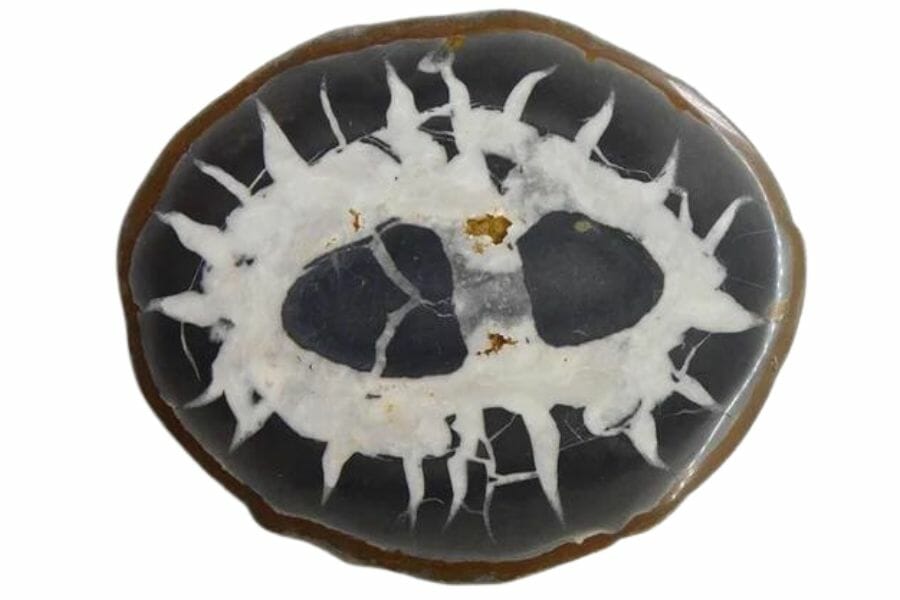Septarian nodules are some of the most fascinating and beautiful geological creations that you can find. Sometimes called “Lightning Stones” they might look like ordinary rocks on the outside, but inside, they reveal a beautiful pattern that tells a story of how our planet has changed over millions of years.
How do these amazing formations come to be? What do they look like, and how can you identify them if you find one? Are they valuable?
We’ll explore the fascinating world of septarian nodules, uncovering the secrets of their formation, appearance, and importance. Whether you’re a curious student or an avid rock collector, prepare to embark on a geological adventure that connects us with the ancient world.
What Septarian Nodules Are
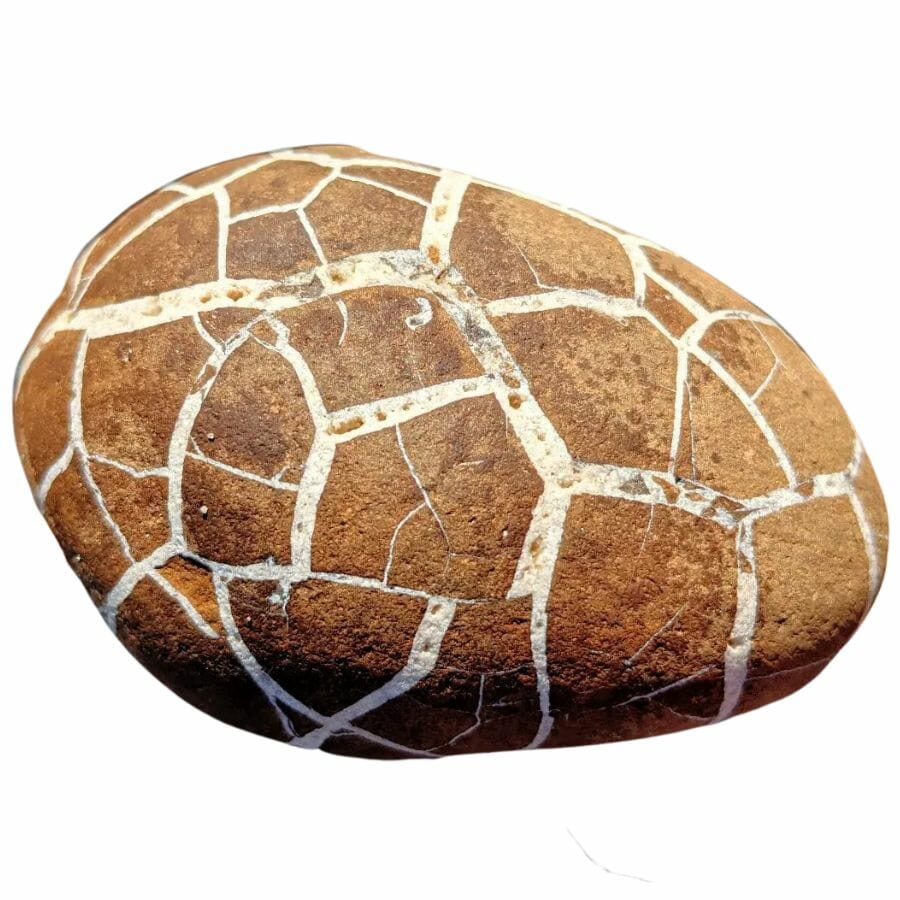
Septarian Nodules may look ordinary at first glance, but when you crack them open, they reveal a stunning pattern of cracks filled with various minerals.
Inside the nodule, you might find calcite, which is often yellow and forms the inner layers. Aragonite, which might be brown or reddish-brown, fills in the cracks, creating the distinctive patterns.
You can also often find quartz or siderite in some areas.
The outer shell or wall of the nodule is typically made of limestone or mudstone, containing various forms of calcium carbonate mixed with clay and silt. In some cases, there can be other minerals present, like pyrite or siderite.
The combination of these minerals creates the beautiful designs that make septarian nodules a favorite among rock collectors and geology enthusiasts.
Each septarian nodule is like a work of natural art, with its own unique composition and appearance. Whether used in jewelry or simply admired for their inherent beauty, these nodules are a wonderful testament to the creativity and complexity of our planet’s geological processes.
How Septarian Nodules got their name
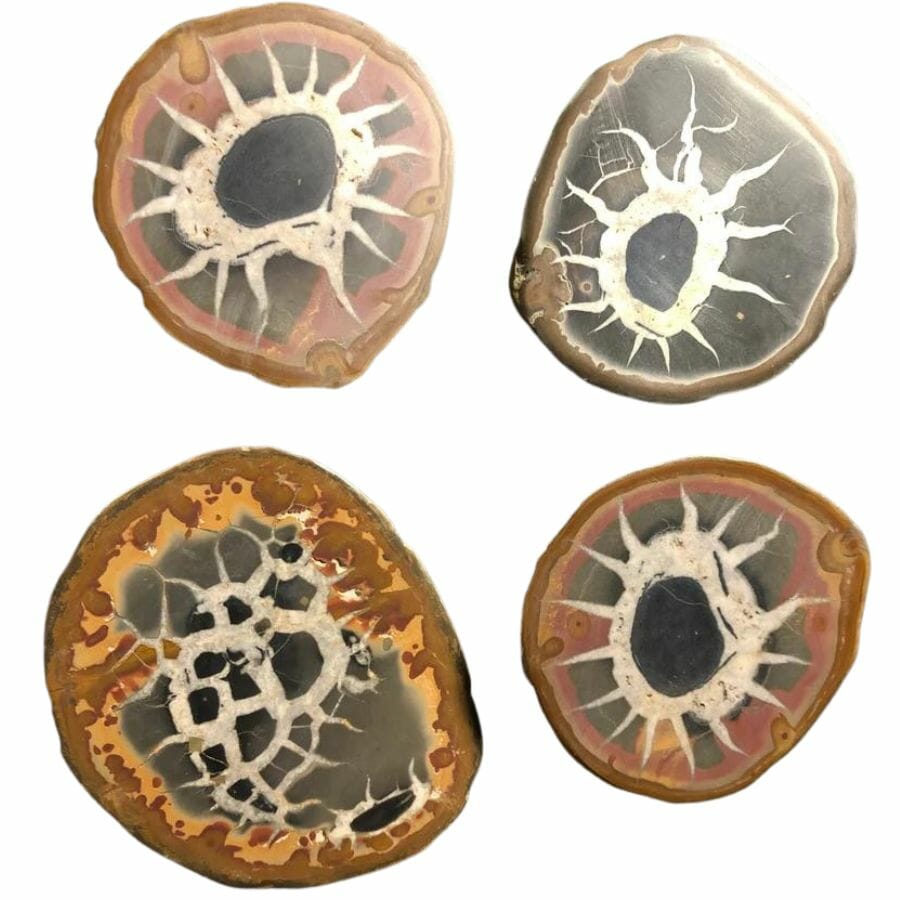
Septarian nodules get their name from the Latin word “septum,” which means “partition” or “sept,” referring to the seven. This name is in reference to the cracks or partitions that form within the nodule.
The characteristic cracking pattern typically divides the stone into segments, often creating a network of seven or more divisions. These cracks are filled with various minerals, creating the beautiful designs seen inside the nodules.
The name “septarian” reflects both the appearance of these nodules and the distinctive geological process that creates them, giving us a hint at the internal structure even if the nodule hasn’t been cracked open.
It’s a fitting name for these intriguing geological formations, connecting their appearance to the Latin root of their name.
Are septarian nodules natural
While they certainly look unusual enough to question their origin, septarian nodules are naturally occurring geological formations. They form in sedimentary rock, usually when minerals precipitate within the mud or clay. Over time, the minerals harden and create these distinct nodules.
It is certainly possible to create fakes but they aren’t valuable enough for that to be worthwhile.
What’s special about septarian nodules
The beautiful secret held inside every septarian nodules is what really makes them memorable for anyone that finds one. While they may look like regular rocks on the outside, when cracked open, they reveal a stunning pattern of cracks filled with various minerals.
This creates a captivating design that makes each nodule unique. Few other geological formations can make a claim like this!
How Septarian Nodules Form
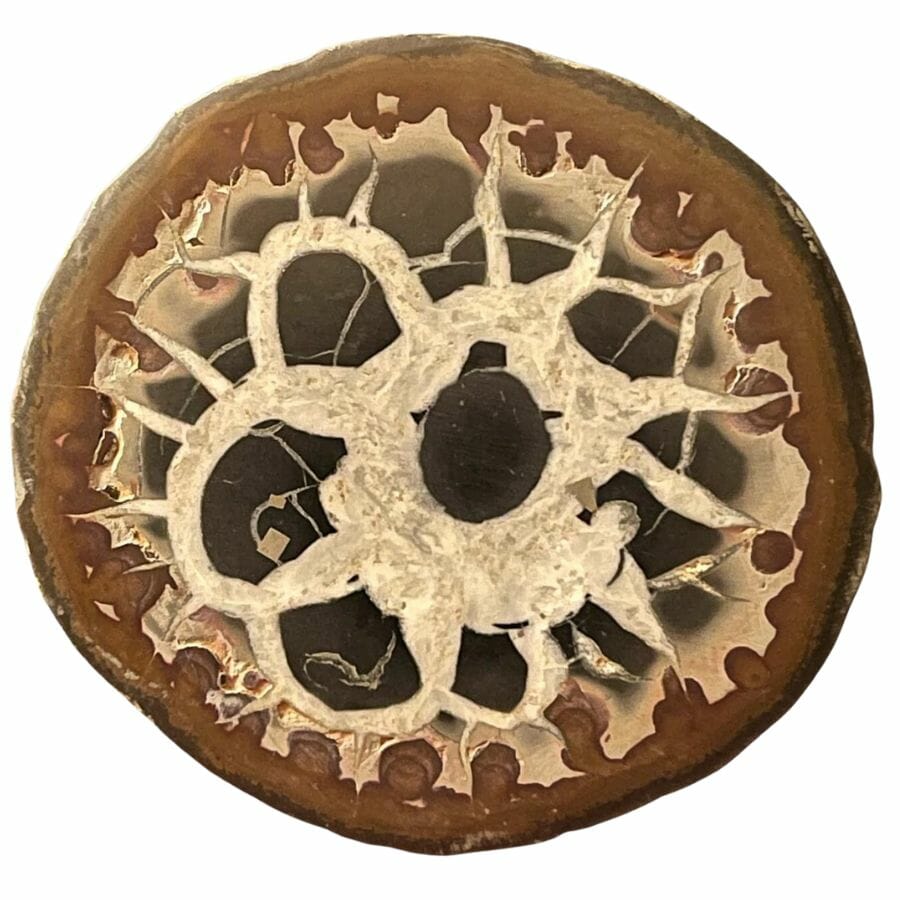
The formation of septarian nodules is a fascinating process that takes millions of years. It all starts with mud, clay, and organic material like shells and dead sea creatures mixing together to form mud balls.
These balls are then buried under more sediment, and as they dry, they begin to crack.
As time goes on, the cracks in the mud balls are filled with minerals from the surrounding environment. Minerals like calcite, aragonite, and sometimes others seep into the cracks and begin to harden.
The different minerals fill the cracks in unique patterns, giving each nodule its special appearance.
What’s really interesting is that the outer shell of the nodule, made of limestone or mudstone, hardens faster than the inside. This creates pressure that leads to more cracks and more opportunities for minerals to fill in the spaces.
Over time, these minerals crystallize and bond together, turning the once soft mud ball into a solid, beautiful nodule.
What Septarian Nodules Look Like
It isn’t always easy to tell that you have a septarian nodule from the outside but there are ways to do it. Here is what they look like on the outside and inside as well as rough and cut and polished:
Raw septarian nodules
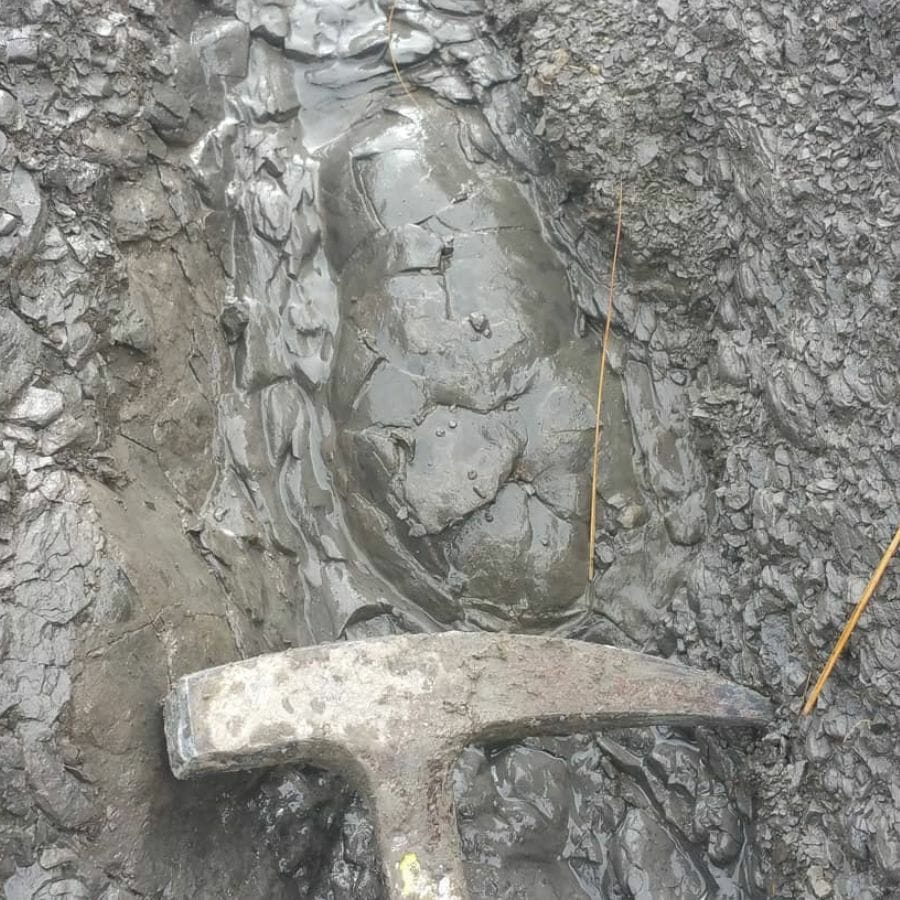
Rough, unpolished septarian nodules might not look very remarkable at first glance. They often resemble ordinary rocks, and without cracking them open, it might be hard to tell what’s hidden inside.
Typically, they are round or oval in shape, but what makes them special is hidden beneath the surface.
The exterior of a rough septarian nodule might be covered with a layer of limestone or mudstone. It can be grey, brown, or a muddy color and usually lacks the bright and vivid appearance of the inside. Some might even have a slightly bumpy or uneven surface.
Cut or polished septarian nodules
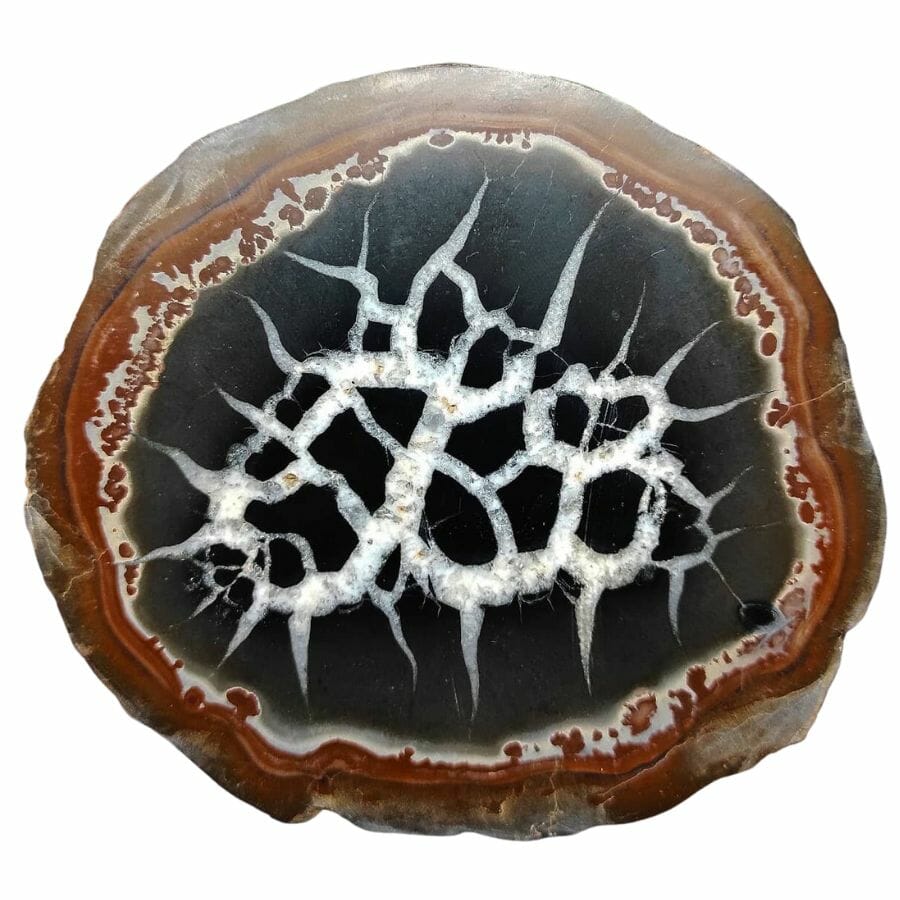
Cut or polished septarian nodules are a stunning sight to behold, revealing their hidden beauty. When these nodules are sliced open or polished, the intricate network of cracks filled with minerals becomes visible, displaying an extraordinary pattern that makes each nodule unique.
Inside, you might find bright yellow calcite forming the inner layers, while other minerals like brown or reddish-brown aragonite fill in the cracks. It stands out even among the most beautiful yellow rocks.
The contrasting colors and patterns create a captivating design that can resemble anything from abstract art to a spider’s web.
The polishing process brings out the shine and luster of the minerals, enhancing their appearance and making the patterns even more vibrant. The way the minerals have filled the cracks creates a beautiful mosaic effect, with each mineral adding its own color and texture.
Where You Can Find Septarian Nodules
These nodules can be found in quite a few places in the US as well as around the world. As you’ve seen in our guide on where to go rockhounding, we know of a LOT of great spots.
We’re going to highlight a few of the very best places to find septarian nodules below as well as provide a list of several other places worth trying.
Always Confirm Access and Collection Rules!
Before heading out to any of the locations on our list you need to confirm access requirements and collection rules for both public and private locations directly with the location. We haven’t personally verified every location and the access requirements and collection rules often change without notice.
Many of the locations we mention will not allow collecting but are still great places for those who love to find beautiful rocks and minerals in the wild without keeping them. We also can’t guarantee you will find anything in these locations since they are constantly changing.
Always get updated information directly from the source ahead of time to ensure responsible rockhounding. If you want even more current options it’s always a good idea to contact local rock and mineral clubs and groups
Western Michigan
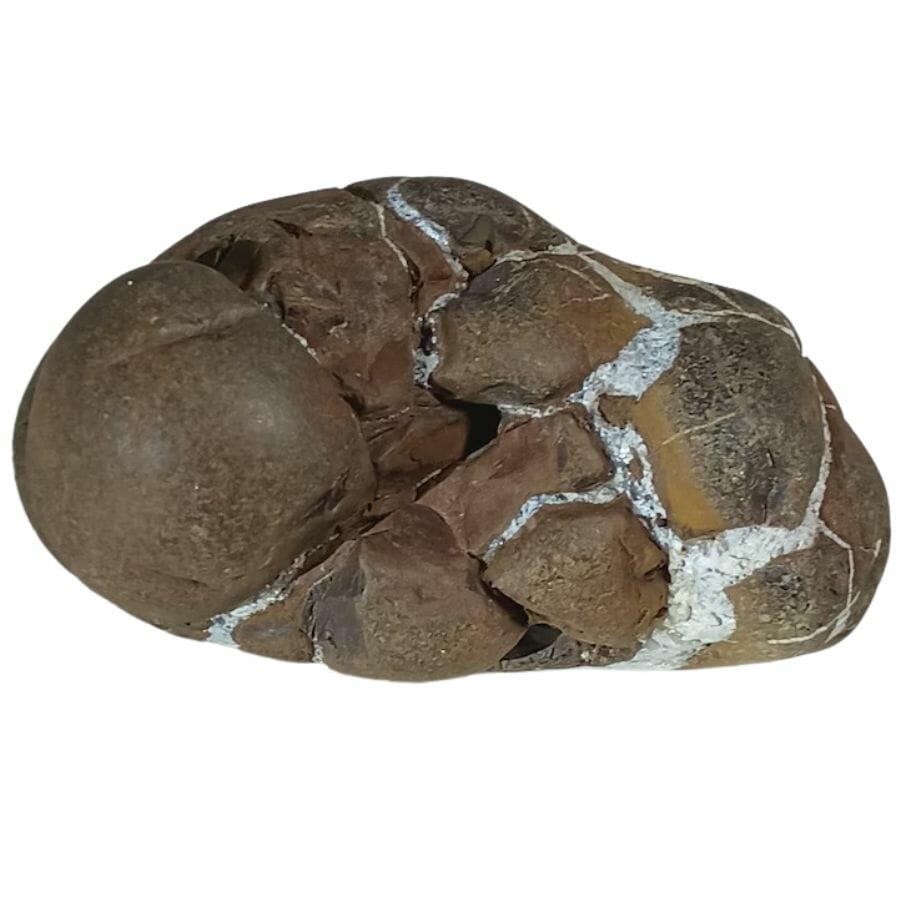
Western Michigan has a diverse landscape that includes sandy shores along the Great Lakes, fertile farmlands, and rolling hills. Geologically, the area is known for its layers of sedimentary rocks like limestone and shale, which were formed millions of years ago when the region was covered by shallow seas.
The area’s geography is shaped by the Great Lakes, particularly Lake Michigan, which affects the climate and the soil. The lakes and rivers in Western Michigan have carved out beautiful valleys, and the glacial history of the area has left behind rich soil that’s great for farming.
Additionally, there are forests and sand dunes, making Western Michigan’s landscape varied and interesting and one of the best places for mining for crystals. Whether it’s the beaches, the farmlands, or the forests, the geology and geography of Western Michigan offer a unique combination of features that make it a fascinating place to explore.
Where you can find septarian nodules in Western Michigan
South Haven is one of the most popular places for finding septarian nodules, especially around Deer Lick Creek and the Holland area (Pier Cove). You can also find success in Fennville, Van Buren Park, and along the shores of western Lake Michigan.
You should also check out our full guide to rockhounding Michigan here for more ways to find incredible rocks and minerals.
South Eastern Utah Around Muddy Creek
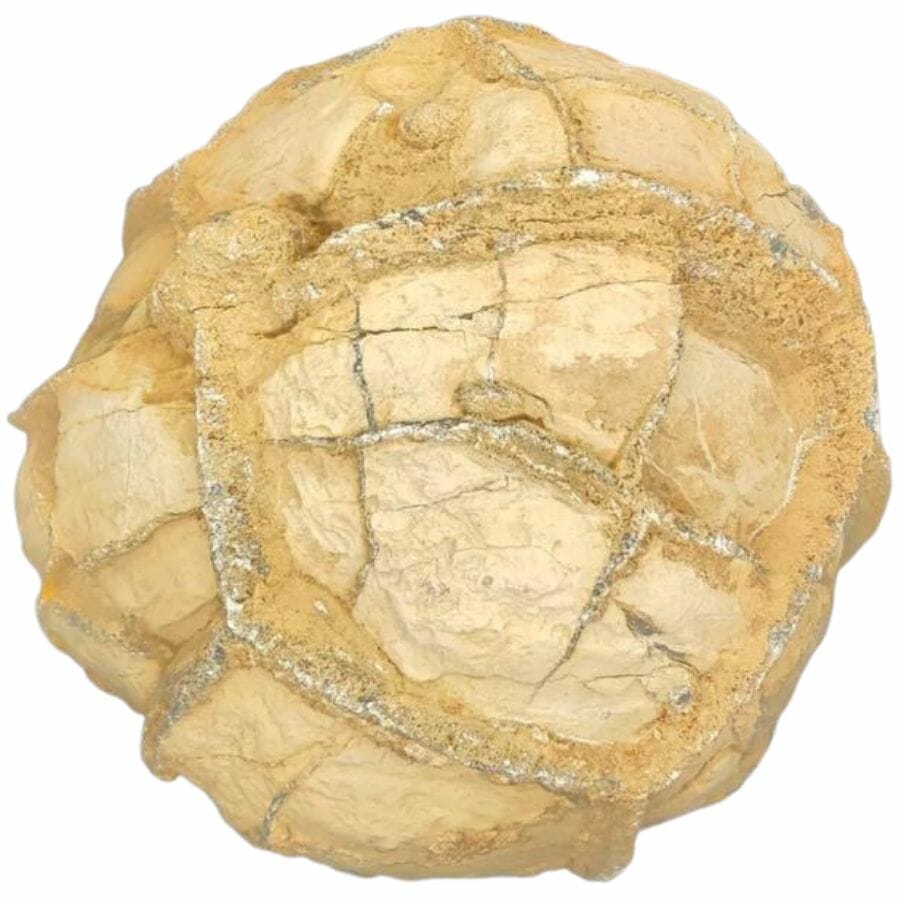
Muddy Creek is a 72-mile creek that meanders through the desert landscape of central Utah, creating a winding path through valleys and gorges. It flows through various rock types, including sandstone and shale through Emery, Sanpete, Sevier, and Wayne counties.
Over millions of years, the water has eroded these rocks, carving out deep canyons and creating stunning formations that tell the story of the Earth’s history in this region.
The combination of geology and geography in the Muddy Creek area makes it a fascinating place for scientists, explorers, and nature enthusiasts, especially those who are interested in finding gems. Its unique formations and the life it supports are a testament to the power of water and time in shaping the landscape.
Where you can find septarian nodules in South Eastern Utah
Muddy Creek is one of the most famous and productive areas in the world for septarian nodules. There are tons of outcrops and areas of erosion along the creek that are great places to look.
State-By-State Guide
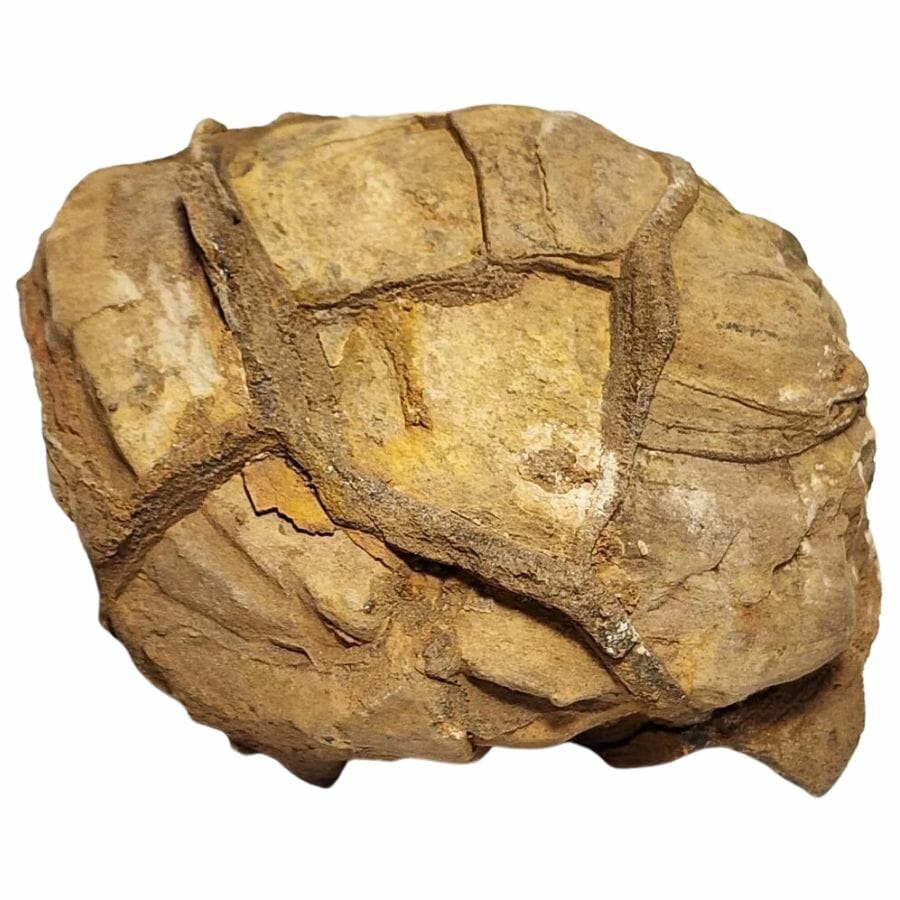
Here are several more places you can try in various states around the US:
| State | Location |
| Alabama | Clarke County banks and road cuts especially around Saltipa |
| Arkansas | Madison County around Huntsville |
| Arkansas | Searcy County road cuts around Leslie |
| Arkansas | Washington County around Cato Springs |
| Arizona | Gila County along the North Creek Trail |
| California | Barstow County hillsides around Leadpipe Springs |
| Colorado | Fremont County around the Canon City dump |
| Kansas | McPherson County in Freemount South of Route 4 and around Roxbury Hill |
| Kansas | Mitchell County around Blue Hills |
| Kansas | Norton County in the Cavlert area |
| Kansas | Osborne County around Hobbie Lake and south of Osborne |
| Louisiana | De Soto Parish in the road and railroad cuts around Frierson |
| Louisiana | Sabine Parish around Pleasant Hill |
| Missouri | Adair County along the Chariton River |
| Missouri | Buchanan County along Sugar Creek |
| New Mexico | Sandoval County in the Naciminto Mine |
| Oklahoma | Tulsa County in the road cuts around Tulsa |
| Texas | Dallas County in southwest Dalls around the Eagle Ford shale formation beds |
| Texas | Grand County in the Crescent Junction area and around Burro Seeps |
| Texas | Kane County sedimentary deposits around Mount Carmel and Orderville |
| Utah | Juab County hillsides and places of erosion around Mount Carmel |
| West Virginia | Hardy County road cuts around Moorefield |
Finding septarian nodules outside of the US
There are quite a few places outside of the US where you can also find septarian nodules including:
- United Kingdom – Especially along the Jurassic Coast
- New Zealand – In coastal areas
- Madagascar
- Morocco
- Australia – Along the southern coast
These are all locations where the specific geological processes needed to form the nodules, including the drying and cracking of ancient mud, were happening. There are likely many other places around the world where this is the case. Let us know if you know of any!
How To Find Septarian Nodules
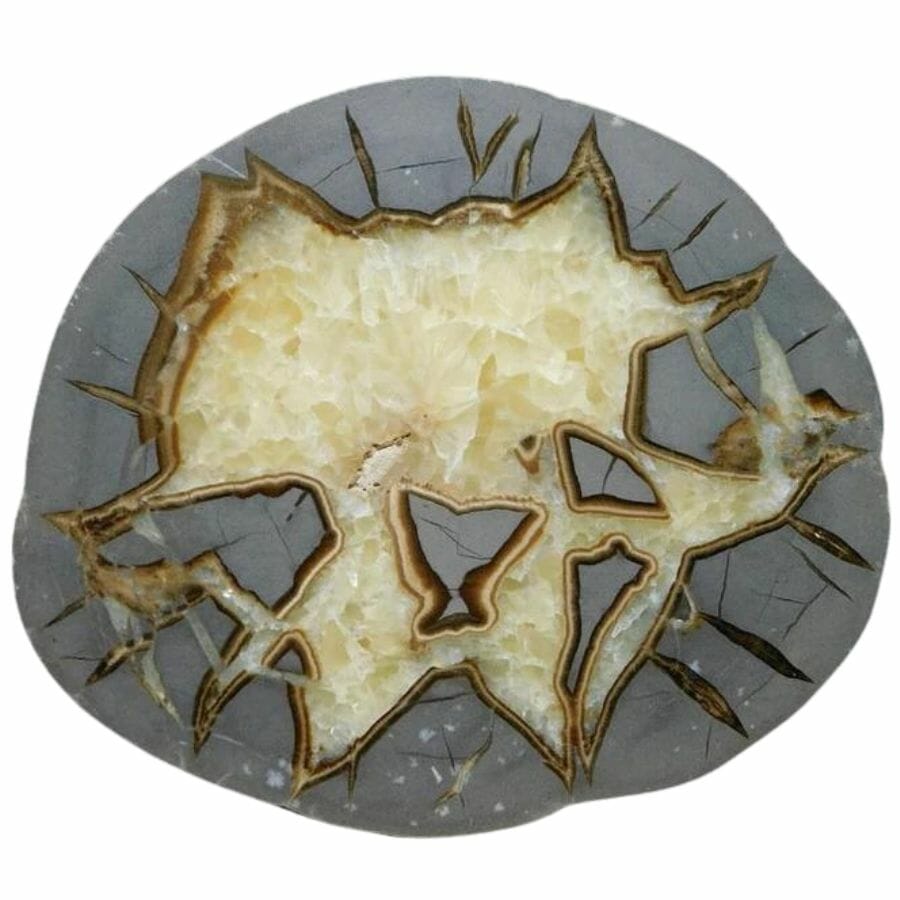
Now that you know of several great places you can look we wanted to give you some additional guidance on how to actually find the septarian nodules that are there.
You are going to be specifically looking for areas that were once ancient sea beds or muddy areas since those are the locations where the nodules will have formed. There are a few places where you are likely to have the best luck finding them without actual mining just by using our typical kit of basic rockhound equipment:
River and creek beds
River and creek beds are great places to find septarian nodules because of the way these unique rocks form and the natural actions of the water. Rivers and creeks naturally erode the land as they flow, exposing layers of rock and soil.
This means that over time, septarian nodules that were once buried can be uncovered and washed into areas where they are easier to find. The flowing water can also wear away the outer layers of the nodule, revealing the unique and interesting patterns inside.
The combination of the right formation conditions and the action of the water makes these locations prime spots for discovering these geological treasures.
Exposed cliff faces
In a cliff face, the layers of rock that have built up over millions of years are often visible. Erosion and weathering can wear away the softer layers of rock, revealing the harder, more resistant rock layers.
This can expose the septarian nodules that may have been buried deep within the cliff.
The exposed cliff face acts like a window into the geological past, allowing you to see the layers where septarian nodules might be found. If you know what to look for and carefully examine the layers, you can have a lot of success.
Road cuts
Road cuts are places where the earth has been dug away to make room for a road, and they are great for finding septarian nodules. When a road is built, big machines dig into the earth, sometimes cutting through layers of rock that have been hidden for millions of years.
Septarian nodules form in old mud beds, and these layers can be exposed in road cuts. The digging for the road can uncover these hidden treasures, making them easier to find.
Because road cuts can show layers of rock just like a book shows pages of history, they are often explored by geologists and rock collectors. Just be sure to stay safe and follow any local rules, as road cuts can be near busy roads.
How To Identify Septarian Nodules
Whether you’re out in the field looking for nodules or have a few likely suspects in your collection identifying a septarian nodule isn’t always easy. We’ll give you a few ways below that will make the process a lot easier.
Identification from the outside
Here are a couple of ways to identify them from the outside:
A round or oval shape
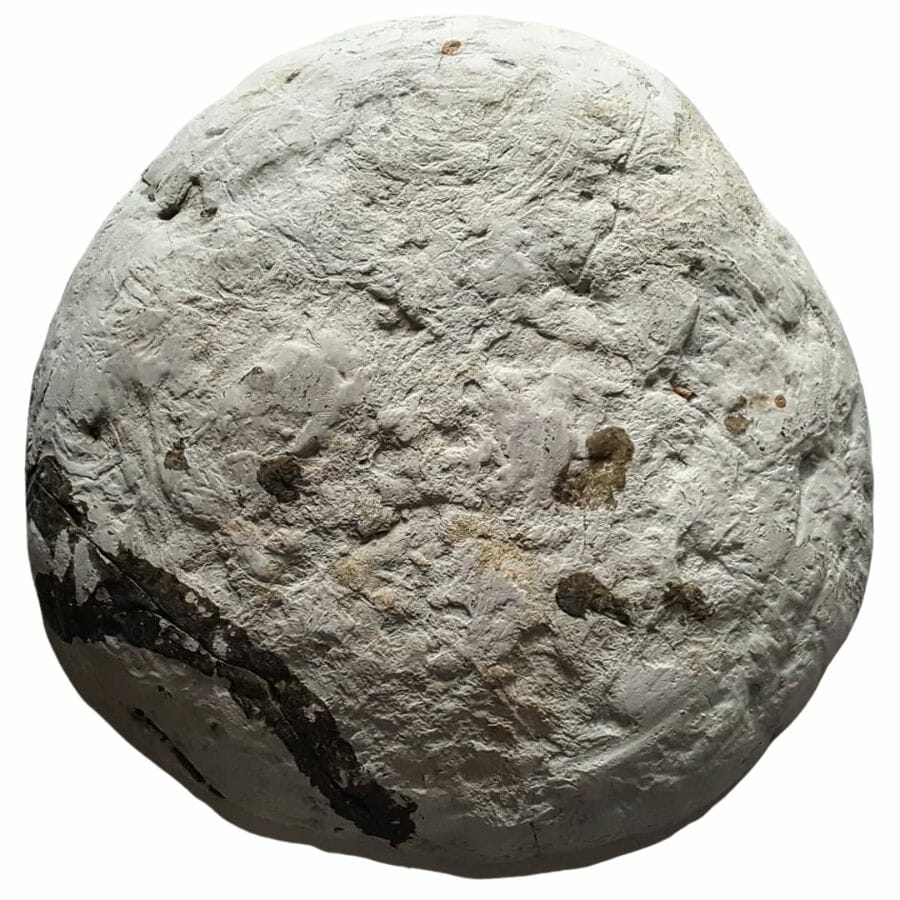
The shape of a septarian nodule is usually round or oval, like a ball that’s been slightly squished. This shape comes from how they form, starting as balls of mud that dry out and crack.
It is unusual to find nodules that are primarily composed of flat surfaces.
Cracks on the surface
Septarian nodules have a very distinctive cracked surface that looks like a spider web or a network of lines. These cracks are filled with different minerals, and the pattern they create is unique to septarian nodules.
If you find a rock with this kind of cracked appearance, it could very well be a septarian nodule.
Color Variations
On the outside of a septarian nodule, you might notice different colors within the cracks. These colors correspond to the various minerals that have filled in the cracks over time.
The contrasting colors can make the nodule look quite beautiful and are a good clue that you’ve found a septarian nodule.
Identification from the inside
Once you cut them open septarian nodules tend to be a lot easier to identify. This is what you should look for:
Beautiful Mineral Patterns That Can Look Like Lightning
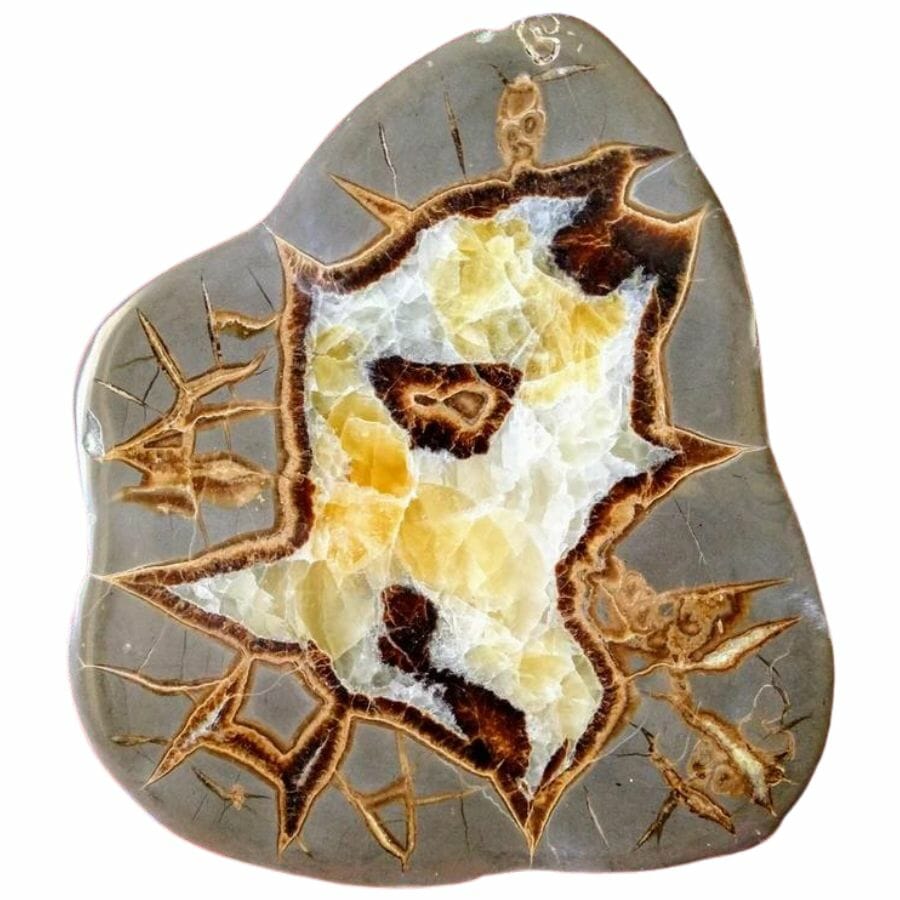
When you cut open a septarian nodule, you’ll see a stunning display of different minerals inside. These minerals create unique patterns and can include calcite, aragonite, and sometimes even quartz.
The way these minerals are arranged can look like a beautiful piece of art, and it’s a big clue that you have a septarian nodule.
Contrasting Colors
Inside the nodule, you’ll often find contrasting colors that create an eye-catching design. The colors correspond to the different minerals that have filled in the cracks. This mixture of colors is not only beautiful but also helps to identify the rock as a septarian nodule.
Hardness of Interior Minerals
The minerals inside a septarian nodule are typically quite hard. If you try to scratch them with a common tool, you might find that they are more resistant than other rocks. This hardness is a result of the types of minerals inside the nodule and helps to identify it.
Identifying septarian nodules using geological properties
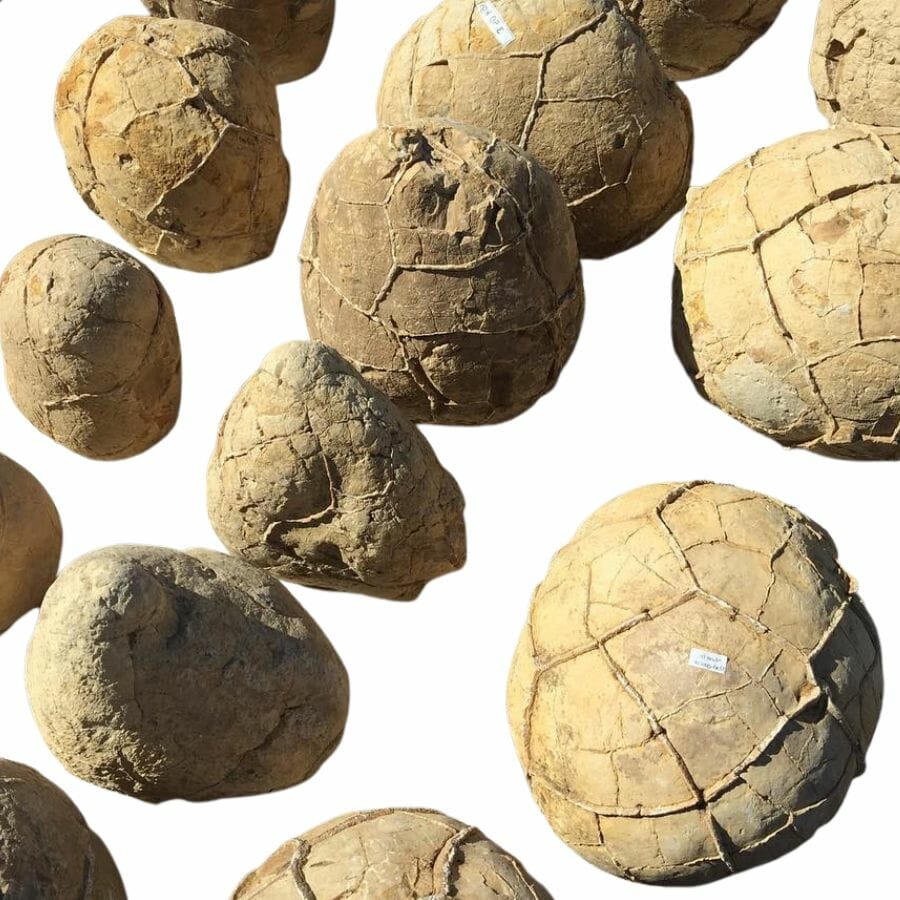
If you have access to more sophisticated tools or are just curious about how to spot septarian nodules using more scientific geological properties we have that info as well! Since these nodules are composed of multiple different substances it’s can be a bit tricky though.
Here are the common properties of septarian nodules:
Chemical composition
The most common components of septarian nodules and their corresponding compositions are:
- Calcite (CaCO3)
- Aragonite (CaCO3)
- Quartz (SiO2)
- Siderite (FeCO3)
- Clay and mud of various compositions
Color
The most common colors you will see are:
- Yellow-Brown
- White or Clear
- Gray
- Dark Brown or Black
- Reddish-Brown
Hardness
Given the variation in composition, you will typically see the following hardnesses on the Mohs scale:
- Calcite – Generally has a Mohs hardness of 3
- Aragonite – Similar to calcite, with a hardness of around 3 to 4
- Quartz – If present, quartz has a Mohs hardness of 7
- Siderite – Typically has a hardness of 3.5 to 4
Density
You will see the following densities of the common components:
- Calcite – Around 2.71 g/cm³
- Aragonite – Approximately 2.95 g/cm³
- Quartz – About 2.65 g/cm³
- Siderite – Roughly 3.96 g/cm³
Refractive index
The refractive indexes you will most likely run into are:
- Calcite – Around 1.49 to 1.66, depending on the crystal orientation
- Aragonite – Approximately 1.53 to 1.68, depending on orientation
- Quartz – Generally around 1.54
- Siderite – About 1.63 g/cm³
Crystal form
The internal structure of a septarian nodule typically includes cracks or fissures that have been filled with minerals. These fissures form in distinct patterns, often radiating from the center, and the minerals within them may crystallize in different ways.
For example, calcite might form in a rhombohedral crystal system, while quartz crystallizes in a hexagonal system. The overall form of the nodule itself doesn’t correspond to a specific crystal system but is more related to the environmental conditions during its formation, such as the drying and cracking of the surrounding mud.
Luster
You will usually see the following lusters of the various components:
- Calcite – Often exhibits a vitreous (glass-like) to pearly luster
- Aragonite – Typically has a vitreous to sub-vitreous luster
- Quartz – Generally has a vitreous luster
- Siderite – May show a vitreous to pearly luster
The Uses Of Septarian Nodules
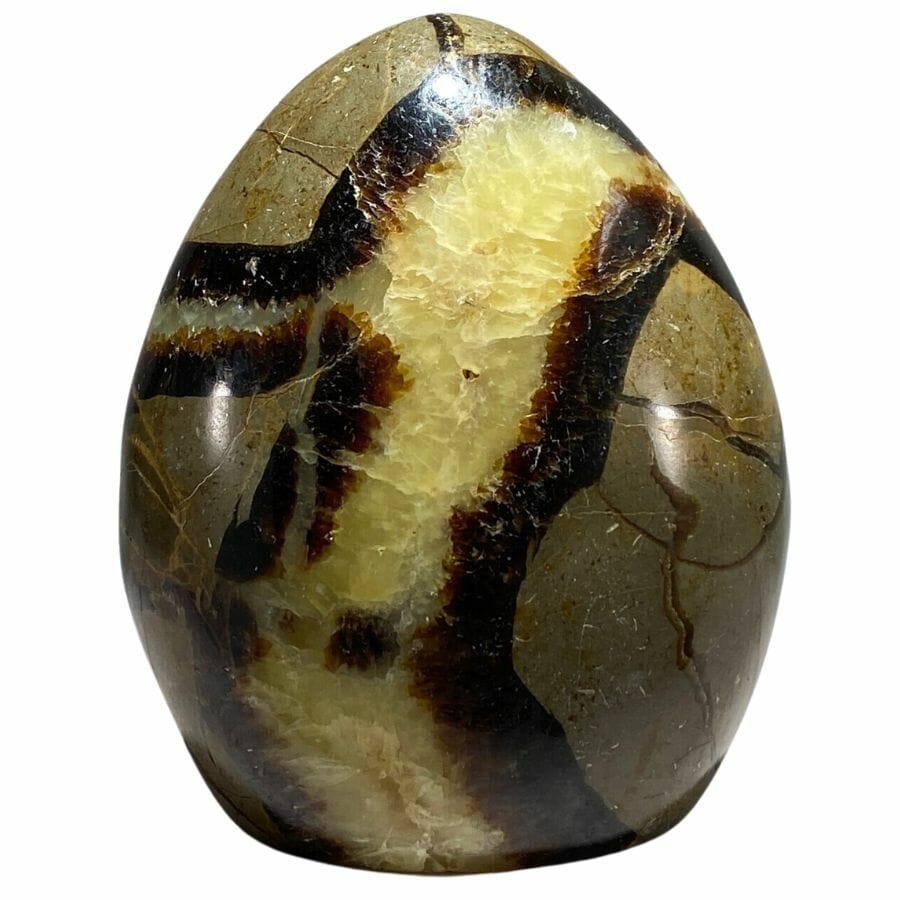
One of the most popular uses for septarian nodules is for decorative purposes. Because of their unique appearance, they are often cut and polished to make stunning display pieces for homes or museums.
Some artists even use them to create jewelry or sculptures.
In addition to their visual appeal, septarian nodules are sometimes used in metaphysical practices. Some people believe that these stones have healing properties and can promote emotional well-being.
While scientific support for these ideas is limited, the belief in their spiritual significance adds another layer to the interest in these intriguing geological formations.
Finally, septarian nodules are valuable to geologists and educators. Studying them can provide insights into ancient environmental conditions, like the climate and the presence of water in an area.
Teachers and students might use them as examples to understand geological processes, making them an educational tool as well.
How Much A Septarian Nodule Is Worth
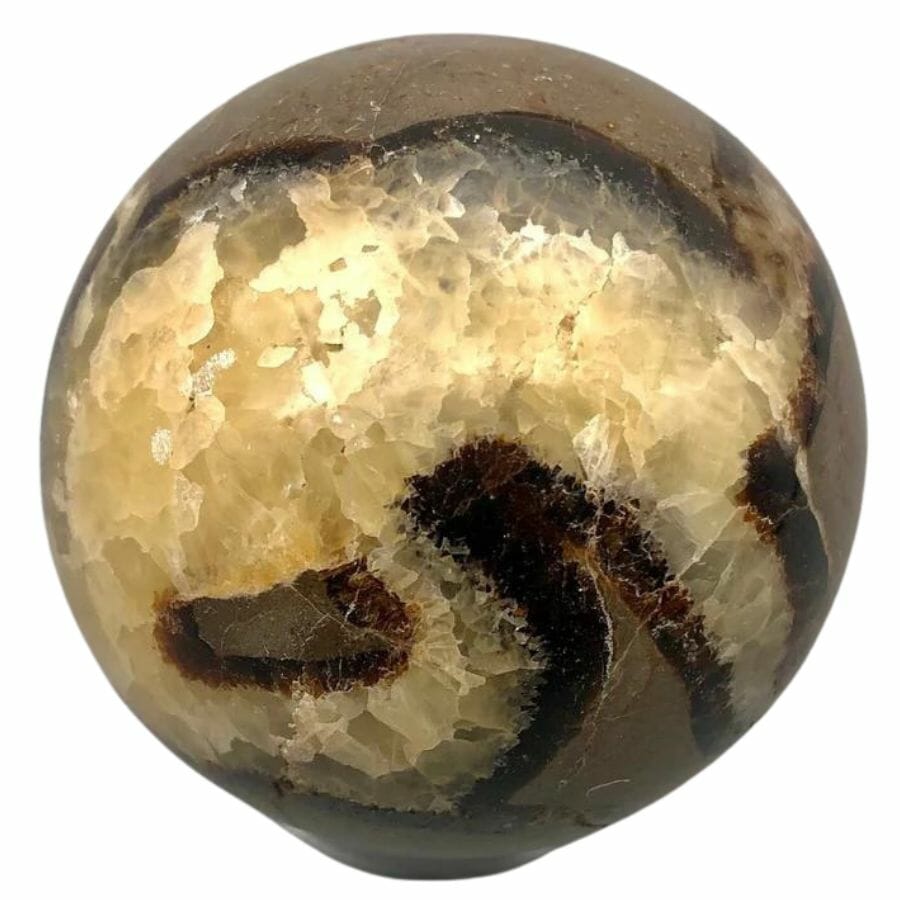
The value of a septarian nodule can vary widely depending on its size, quality, the complexity of the patterns inside, and how it’s been prepared or displayed.
Small, unpolished nodules might sell for just a few dollars, while larger and more intricate specimens can be much more valuable. If a nodule has been cut, polished, and presented in a way that highlights its unique features, it can fetch a higher price.
Artistic pieces made from septarian nodules, such as jewelry or sculptures, can also be more valuable.
Prices can range from as little as $5 to $10 for smaller, unpolished pieces, to several hundred dollars or more for large, high-quality, polished specimens.
It’s always a good idea to consult with a knowledgeable rock and mineral dealer that has certifications from respected authorities like the GIA to determine the specific value of a particular septarian nodule, as the price can fluctuate based on current demand and trends in the market.

